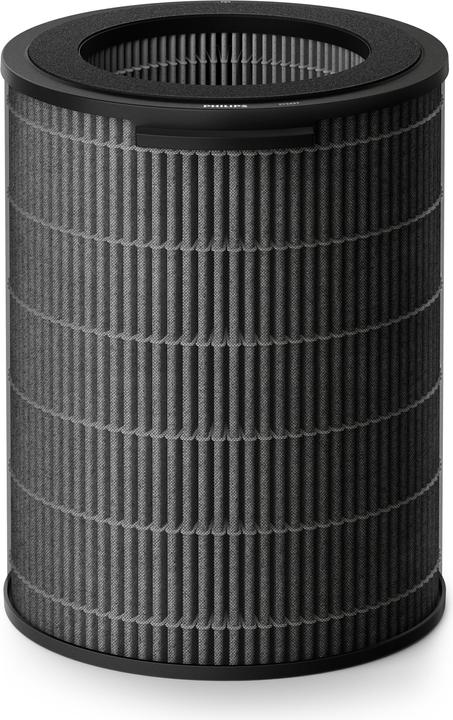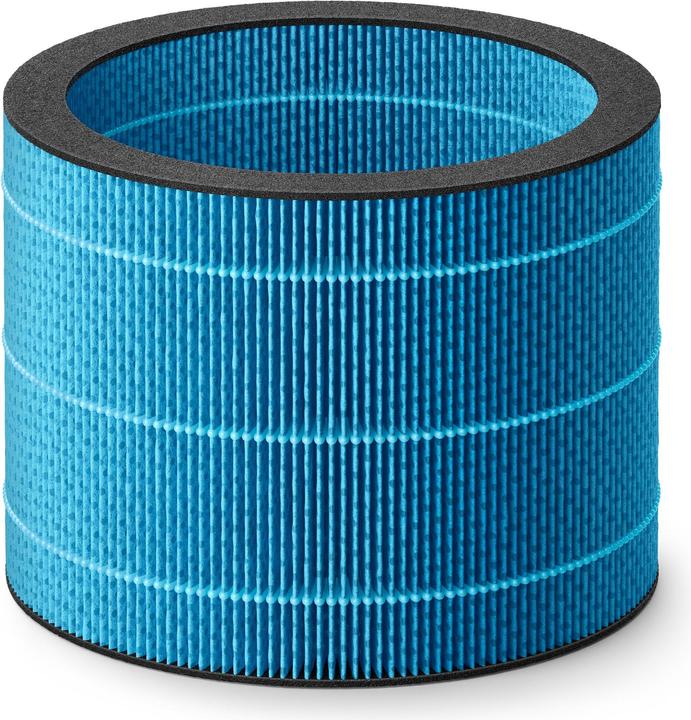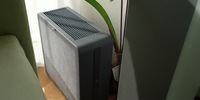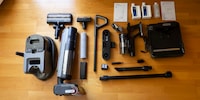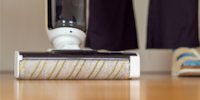

Philips AC3737/10 review: this tower battles bad air
I tested a combination device from Philips that both cleans and humidifies air. It’s both big and powerful, but I still wouldn’t recommend it to my in-laws.
So there it is: 75 cm tall, with a 30 cm² base and weighing almost 8 kg. The AC3737/10 is reminiscent of the defence tower on a medieval castle. With the difference being the air purifying humidifier doesn’t fight any advancing robber knights. Its enemies are dry air and pollutants.
Philips provided me with this device to put through its paces – I’ve been using it for several weeks now. However, I should point out that Philips has no influence over this review, as is the case with all our editorial tests.

Wi-Fi integration: purely pot luck
The company probably already told me about the AC3737/10’s shortcomings – and I don’t just mean its unpronounceable name. Getting the device to join your home Wi-Fi takes nerves of steel and is a bit of a gamble. I tested it in three different households with different Wi-Fi equipment. Nowhere did I manage to connect the AC3737/10 to the network straight away. Sometimes it couldn’t be found, other times switching from the device-generated network to the user’s own Wi-Fi didn’t work. Funnily enough, it always did on the third or fourth attempt, but I’m not sure what was different.
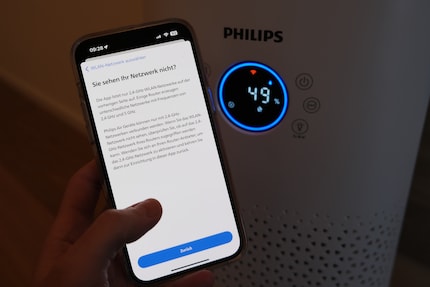
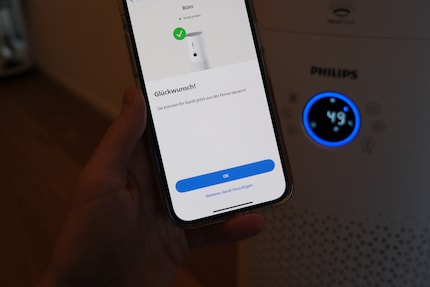
Source: Martin Jungfer
If I hadn’t already added a number of devices to the Wi-Fi and therefore known about the quirks that this can have, I’d probably have quickly given up in frustration. Evidently, I can’t add the AC3737/10 to someone’s home if they’re not very tech-savvy, such as my in-laws. Or only if I can get it to work there myself. Even afterwards, there are still some technical pitfalls lurking. But more on that later.
Performance as a filter
First, let’s look at hardware. The AC3737/10 consists of two parts. The base is the air purification unit. It’s a good half-metre tall, with a 30 cm filter inside. The performance data is impressive for this price range:
- 99.97% filter performance of 0.003 micrometre particles (allergens)
- 99.9% filtering of viruses and aerosols
- filtration via HEPA and activated carbon filters as well as a pre-filter
- filters 505 cubic metres of air per hour for particles and 335 cubic metres for formaldehyde
- Air purification in rooms with a floor area of up to 131 square metres
If you haven’t dealt with values like this before, you might think they’re marketing talk. However, Philips has actually had its performance confirmed by external laboratories and independent tests. The company has also documented this clearly in the footnotes on its own product page (see here). I don’t have lab conditions in my everyday application test, which is why I have to rely on this information.
As a user, I see two air quality values in the app or on the device’s display. A laser on the back – dubbed AeraSense in Philips’ marketing jargon – measures the proportion of PM2.5 particles in microgrammes per cubic metre of air, which is known as breathable particulate matter. Fine dust gets created when vacuuming, frying in the kitchen or even when you sit down on the sofa and stir up the particles, for instance. Particulate matter is measured in microgrammes per cubic metre of air. The Swiss Federal Office of Public Health (FOPH) has compiled helpful information on particulate matter in a leaflet (in German).
Secondly, you’ll see a number on the Philips device that indicates the percentage of allergens according to the IAI (indoor allergen index) scale. This ranges from 1 (good) to 12 (very bad). In terms of allergens, it includes pollen, skin particles from pets, dust mites and mould spores.
I drove the fine dust concentration to dizzying heights when I put it to the test. A smoker’s cigarette caused an increase from 10 to as high as 600. The AC3737/10 quickly recognised this attack and automatically switched to the highest power level, bringing the PM2.5 value back below 10 after just a few minutes – a value that the WHO describes as harmless.
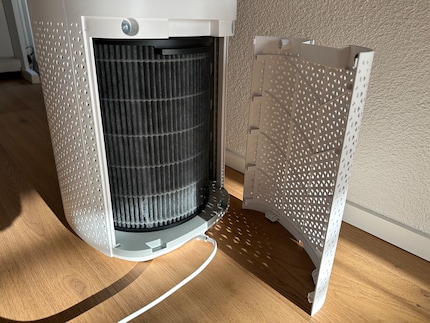
Source: Martin Jungfer
Performance as a humidifier
Especially in the winter months, mucous membranes dry out in the air, making you more susceptible to colds. Ideally, humidity indoors should be between 40 and 60%.
The AC3737/10 ensures that your room air is sufficiently humid. You can set a target value of 40, 50 or 60%. Alternatively, you can set it to maximum. Then the NanoCloud technology – another marketing term – really gets to work, drawing the water molecules from the tank through the filter and distributing them around the room. Unlike spray mist systems, bacteria and limescale particles remain in the water thanks to the filter. This makes the humidified air that comes out incredibly pure.
The four-litre tank also humidifies larger rooms for many hours without any problems. In my test, I only had to top up the water in the open-plan loft apartment after two or three days. That being said, it’s hard to give a generalised figure. Water consumption depends on many factors, such as how dry the air is in your home, how often you ventilate, how dry the air is outside and whether you have a house ventilation system.
I’m happy if I don’t have to refill the water too often. While it’s easy to take off the tank and remove the cover grille, a large capacity also means that the water tank is bulky. In my set-up, it doesn’t fit under the bathroom sink tap. So I can only refill from the shower head or with a watering can.
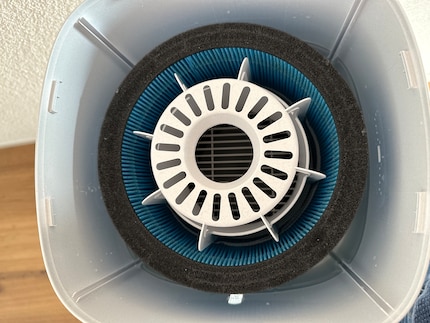
Source: Martin Jungfer
Trying it out
There are two ways I can see the readings for the room air. The display on the device itself only shows one value at a time. If the AC3737/10 is running in 2-in-1 mode, it cleans and humidifies the air. It then shows the current humidity on the display as standard. In air purification mode, the display shows the PM2.5 value. If I press the button with the magnifying glass, the display changes to a different value. There’s no mode for humidification without cleaning.
But I’m actually happy when I don’t have to deal with the display and the six buttons grouped around it. Apart from the on/off switch, none of the symbols are immediately obvious to me. There are also buttons that have a function if you press and hold them, such as activating the child lock. Moreover, there are two buttons you need to press simultaneously to start the Wi-Fi set-up.
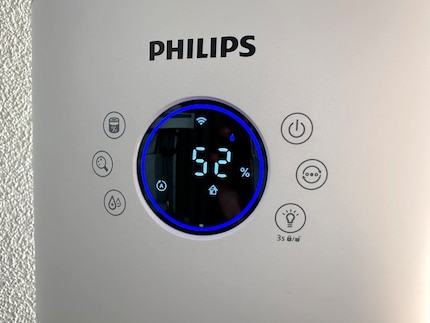
Source: Martin Jungfer
In theory, the AC3737/10 can be operated using the buttons on the device alone. However, it’s easier to control it all via the app as the symbols are labelled. So, next to the house-leaf-water drop pictogram, it also says 2-in-1 mode, which makes it clear what it’s for.
The app also allows me to create a schedule. Theoretically, I can set the AC3737/10 to clean and humidify the air in turbo mode on Tuesdays between 5 and 6 p.m., but only ventilate in snooze mode at weekends.
There’s one thing even the app can’t do and that’s switch from 2-in-1 mode to air purification only. I have to intervene for that. And by that I mean I have to lift the upper part off the device that houses the filter and water tank. This practically exposes the air outlet for the air purifier, which allows the AC3737/10 to work at peak performance. One very user-friendly feature is the way it lets you change the mode simply by lifting the top part – I don’t even have to press a button.
For statistics nerds, the app offers a few graphs for measured values. In theory, you could surmise if your teenage son had been secretly smoking a cigarette or if an incense stick had been lit based on the swing of the curve.
Maintenance and running
Clean, well-hydrated air comes at a cost. And I’m not just talking about the price of purchasing the device. The AC3737/10 operates using two filters. The cleaning filter in the lower part of the device needs to be vacuumed regularly. When the time comes, an icon lights up on the device or the app sends a push notification. In my test, I didn’t need to vacuum until I’d been using it for a good month. You’ll also need a replacement filter after a year or so.
If you regularly use the Philips device as a humidifier, this entails even more work. The water tank will need to be cleaned weekly, which involves adding a bit of washing up liquid to the water and wiping any deposits from the edges. Moreover, the humidifier filter needs to soak in a detergent solution for an hour. The instructions even state the exact composition that’s required. However, after six months, cleaning just won’t cut it and you have to get a replacement filter.
Incidentally, Philips has come up with a solution to make sure you don’t forget to buy one. If the filter isn’t changed, the device will stop working. According to the instructions, this is «to protect the air quality in the room». Only pessimists would think there was another motive.
The replacement filters put a noticeable strain on your wallet. In contrast, the AC3737/10 is very frugal when it comes to electricity costs. It draws just 42 W from the socket in turbo mode. However, in my test, it required between 5 to 10 W in automatic mode. Either way, the monthly electricity costs should only amount to a few francs. For comparison purposes, my economical MacMini runs on 39 W. I could hardly measure the power consumption in standby mode. According to the data sheet, it’s less than 2 W. Fantastic.
The noise level, or lack thereof, also deserves praise. The AC3737/10 is only really perceptible in turbo mode, as air rushes through the appliance at 55 dB. It sounds like a strong autumn wind outside the window. That being said, I never actually use turbo mode, apart from when I test it out.
Verdict
With clean and well-humidified air, the AC3737/10 offers exactly what Philips promises. While I was testing it out, I was particularly impressed by the air purification performance. So I’d definitely recommend this device, especially if you have allergies. When the air’s clean, you don’t just feel it; you can also see it because the ring around the display on the device glows a reassuring blue.
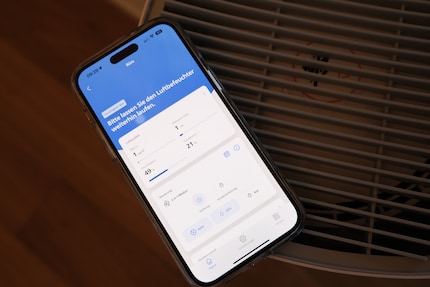
Source: Martin Jungfer
This also means I don’t have to struggle with symbols and the controls. Talking of which, Philips could in fact have made these even more intuitive and easy to understand. It’s not like I want to have to use the app every time.
If the AC3737/10 has enough water in the tank, if the filters are clean and as long as it’s connected to the Wi-Fi, it’s my best friend. But if one of these three boxes isn’t ticked, it annoys me. Refilling the tank is cumbersome, cleaning the filter is time-consuming and replacement filters are expensive. Fortunately, the frustration of setting up the Wi-Fi connection is a one-time thing. Similarly, I only want to move the device once after setting it up given that with 4 l of water in the tank, it weighs 12 kg. As it neither has wheels nor handles, you can’t easily move it somewhere else. Just like the defence tower of a castle.
Got any questions about the AC3737/10? Feel free to ask me in the comments below.
Header image: Martin Jungfer
Journalist since 1997. Stopovers in Franconia (or the Franken region), Lake Constance, Obwalden, Nidwalden and Zurich. Father since 2014. Expert in editorial organisation and motivation. Focus on sustainability, home office tools, beautiful things for the home, creative toys and sports equipment.
